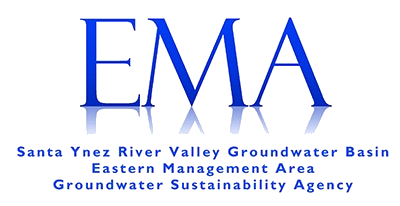AEM Survey - EMA
Aerial Electromagnetic method (AEM) Survey in the Eastern Management Area (EMA) of Santa Ynez River Valley Groundwater Basin
Santa Ynez River Valley Groundwater Basin Aerial Groundwater Mapping
Our community in the Santa Ynez River Valley Groundwater Basin needs a more complete picture of our groundwater resources so that we can make better decisions about managing water into the future. As part of its technical work with the Santa Ynez River Valley Groundwater Basin Eastern Management Area Groundwater Sustainability Agency (GSA), the Santa Barbara County Water Agency is planning to collect groundwater data using innovative aerial technology.
What would normally take the County months to years to survey will only take a few days thanks to new aerial groundwater mapping technology called Aerial Electromagnetic method (AEM).
Watch a video of the AEM technology in action
Groundwater Mapping Goals
The goal of the mapping is to acquire geologic data to help us make better informed decisions to manage our groundwater resources. The geologic data is collected using aerial groundwater mapping technology to characterize and map out the layers and extent of clays, silts, sands, and gravels to a depth of approximately 1,000 to 1,400 feet below the ground surface. Existing well data will be used to verify the survey results. This groundwater mapping study will enhance Sustainable Management Groundwater Act (SGMA) related groundwater modeling and provide a better picture of our groundwater system. The proposed survey area and flight lines are shown on the map below.

Questions and Answers
Answer:
The survey will use aerial groundwater mapping technology to characterize the subsurface geology and better understand where groundwater occurs and flows, which is necessary for the refinement of the hydrogeologic model of the Basin.
2. How does it work?
Answer:

Instruments attached to a low flying helicopter (~100 feet above the ground surface) towing a large hoop will transmit a weak electromagnetic field. This field interacts with the ground, and the response from the ground is measured using a set of receiver coils attached to the hoop. The helicopter flies back and forth along regularly spaced lines and will cover a distance of approximately 497 miles. The instrument can collect data to a depth of about 1400 feet below ground. Once combined and calibrated with well data and existing knowledge of the subsurface conditions, this dataset can be used to map out the layering of “course” materials (sand and gravel), “fine” materials (silts and clay) and bedrock to show the structure of the basin and groundwater system. This new knowledge will help guide placement of new monitoring wells or identification of recharge locations.
Answer:
This project does not pose a risk to health or safety. The very low level of magnetic exposure is about the same as standing one foot from a toaster. The AEM transmitter generates a magnetic field that is lower than 1/100th of the accepted general public exposure level across all frequencies [International Commission on Non-Ionizing Radiation Protection. "Guidelines for limiting exposure to time-varying electric and magnetic fields (1 Hz to 100 kHz)." Health physics 99.6 (2010): 818-836].
The same AEM surveys have been conducted in numerous other locations throughout California with no reported ill effects to humans or animals.
Answer:
Since 2017, projects to map underground groundwater resources have been underway throughout California including:
- Paso Robles
- Pismo Beach
- Marina Coast Water District
- Santa Cruz Mid-County Groundwater Agency
- Tulare Irrigation District
- Kaweah Sub-basin
- Butte County Indian Wells Valley
Answer:
For questions or additional information, please contact:
Matt Young, Water Resources Program Manager
Santa Barbara County Water Agency
Email: mcyoung@cosbpw.net
Phone: (805) 568-3546
Mailing address:
130 E. Victoria Street, Suite 200
Santa Barbara, CA 93101


